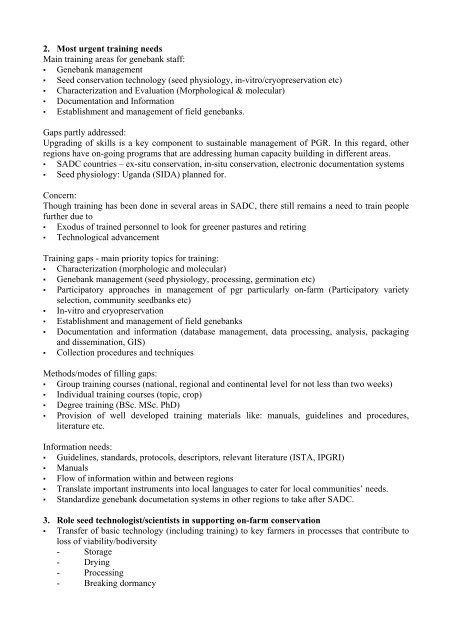Improving the identification, handling and storage of âdifficultâ seeds ...
Improving the identification, handling and storage of âdifficultâ seeds ...
Improving the identification, handling and storage of âdifficultâ seeds ...
You also want an ePaper? Increase the reach of your titles
YUMPU automatically turns print PDFs into web optimized ePapers that Google loves.
2. Most urgent training needs<br />
Main training areas for genebank staff:<br />
▪ Genebank management<br />
▪ Seed conservation technology (seed physiology, in-vitro/cryopreservation etc)<br />
▪ Characterization <strong>and</strong> Evaluation (Morphological & molecular)<br />
▪ Documentation <strong>and</strong> Information<br />
▪ Establishment <strong>and</strong> management <strong>of</strong> field genebanks.<br />
Gaps partly addressed:<br />
Upgrading <strong>of</strong> skills is a key component to sustainable management <strong>of</strong> PGR. In this regard, o<strong>the</strong>r<br />
regions have on-going programs that are addressing human capacity building in different areas.<br />
▪ SADC countries – ex-situ conservation, in-situ conservation, electronic documentation systems<br />
▪ Seed physiology: Ug<strong>and</strong>a (SIDA) planned for.<br />
Concern:<br />
Though training has been done in several areas in SADC, <strong>the</strong>re still remains a need to train people<br />
fur<strong>the</strong>r due to<br />
▪ Exodus <strong>of</strong> trained personnel to look for greener pastures <strong>and</strong> retiring<br />
▪ Technological advancement<br />
Training gaps - main priority topics for training:<br />
▪ Characterization (morphologic <strong>and</strong> molecular)<br />
▪ Genebank management (seed physiology, processing, germination etc)<br />
▪ Participatory approaches in management <strong>of</strong> pgr particularly on-farm (Participatory variety<br />
selection, community seedbanks etc)<br />
▪ In-vitro <strong>and</strong> cryopreservation<br />
▪ Establishment <strong>and</strong> management <strong>of</strong> field genebanks<br />
▪ Documentation <strong>and</strong> information (database management, data processing, analysis, packaging<br />
<strong>and</strong> dissemination, GIS)<br />
▪ Collection procedures <strong>and</strong> techniques<br />
Methods/modes <strong>of</strong> filling gaps:<br />
▪ Group training courses (national, regional <strong>and</strong> continental level for not less than two weeks)<br />
▪ Individual training courses (topic, crop)<br />
▪ Degree training (BSc. MSc. PhD)<br />
▪ Provision <strong>of</strong> well developed training materials like: manuals, guidelines <strong>and</strong> procedures,<br />
literature etc.<br />
Information needs:<br />
▪ Guidelines, st<strong>and</strong>ards, protocols, descriptors, relevant literature (ISTA, IPGRI)<br />
▪ Manuals<br />
▪ Flow <strong>of</strong> information within <strong>and</strong> between regions<br />
▪ Translate important instruments into local languages to cater for local communities’ needs.<br />
▪ St<strong>and</strong>ardize genebank documetation systems in o<strong>the</strong>r regions to take after SADC.<br />
3. Role seed technologist/scientists in supporting on-farm conservation<br />
▪ Transfer <strong>of</strong> basic technology (including training) to key farmers in processes that contribute to<br />
loss <strong>of</strong> viability/bodiversity<br />
- Storage<br />
- Drying<br />
- Processing<br />
- Breaking dormancy

















